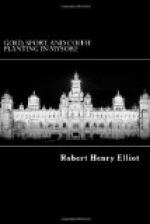My general impression on going through the Bamboo district of Coorg was that it contains a certain proportion of land of poor character (and this can be said of most coffee districts) which should never have been opened, but that there are many excellent and valuable estates, though it was plain to me that, from the more weakly, or perhaps I should rather say less robust, character of the shoots, and the appearance of the soil, it had, as a rule, much less growing power in it, and would consequently require more manure, than the deep and heavier soils of Mysore. But these soils in the Bamboo district, though lighter in character, are of course (and this is a fact of no small importance) more easily worked than those of Mysore. The next point that attracted my attention was the shade, and of the numerous estates that I saw in the Bamboo district there were only two that at all came up to my idea of what a well shaded property ought to be. I could see little signs of the shade being varied in kind and quantity to suit the various aspects, and many trees were preserved which were merely throwing shadow, not on to the coffee, but on to adjacent trees. Then I found that in one excellent piece of young coffee the shade had been planted in lines running from east to west, instead of being closely planted in lines from north to south (vide chapter on shade). The shade, too, generally speaking, was far too largely composed of one kind of tree,—the Atti-mara (Ficus glomerata)—and finally this tree, the defects of which I have remarked upon in my chapter on shade, was badly managed by being trimmed up to a considerable height above the ground. The result of this was that on land on which there was an enormous number of trees there was far too little shade, and a forester fresh from England would never have imagined that the planters had intended to grow umbrageous trees for the double purpose of lowering the temperature of the plantation and sheltering the coffee from sun and parching winds, but would have supposed that they were engaged in growing timber for sale. I saw land which, I feel sure, had at least three times the number of trees that would have been sufficient to shade it fully, had they been properly treated. Such a number of trees throw out, of course, a corresponding number of large roots, and one planter told me that in some instances coffee was being killed by the masses of Atti root in the land. As regards shade, then, there is much room for improvement in Coorg, and especial attention should be paid to this in the Bamboo district which has suffered so much from Borer. This pest, we know, thrives best under warm and dry conditions, and it is therefore of great importance that the kinds of shade most recommended in my chapter on shade should be freely planted, and other kinds gradually removed.




